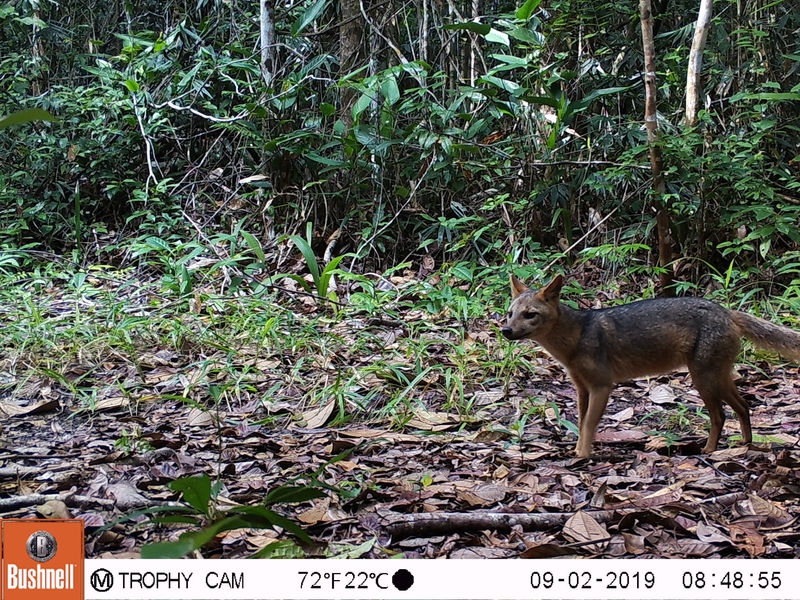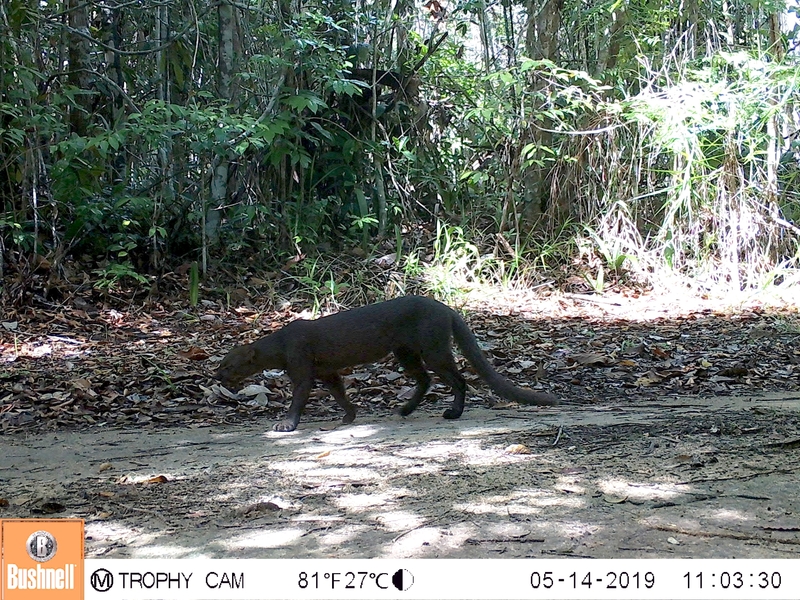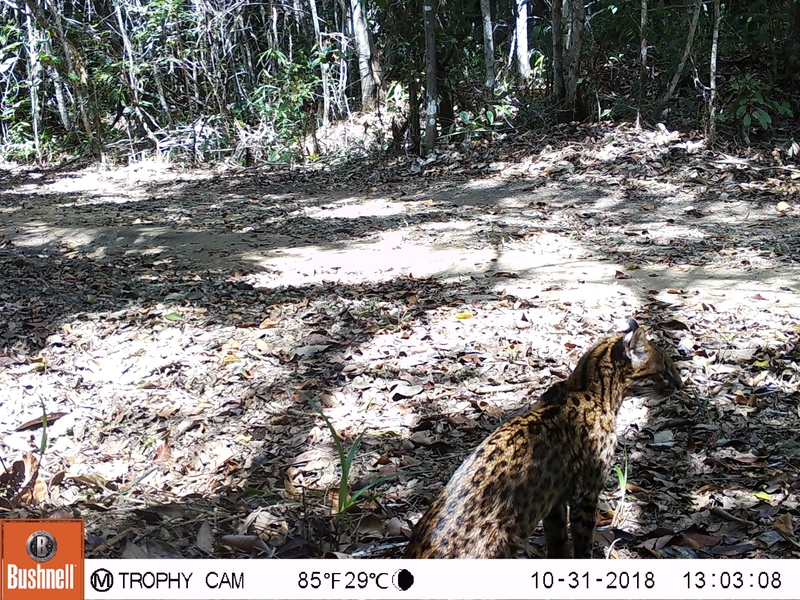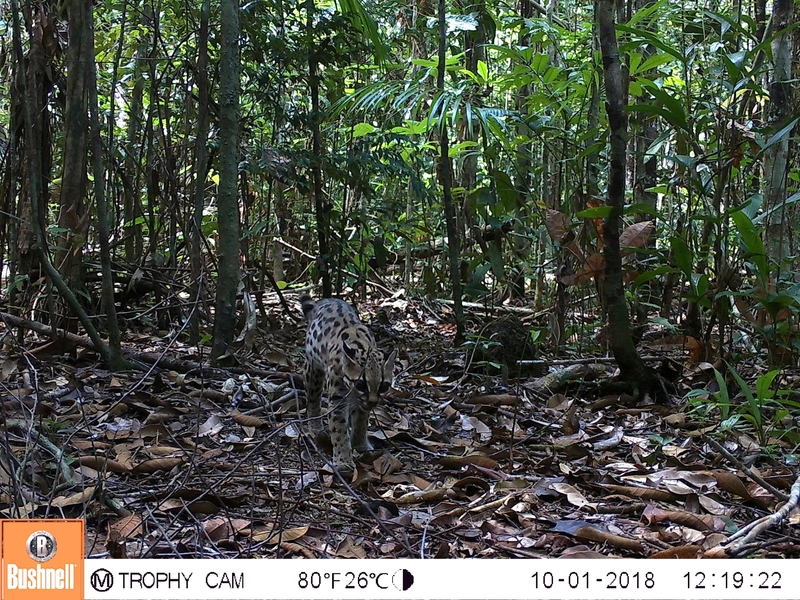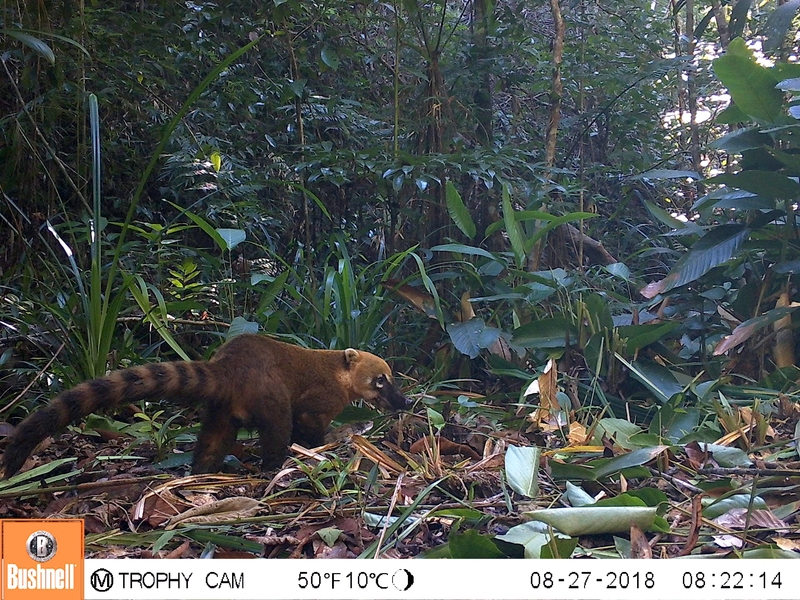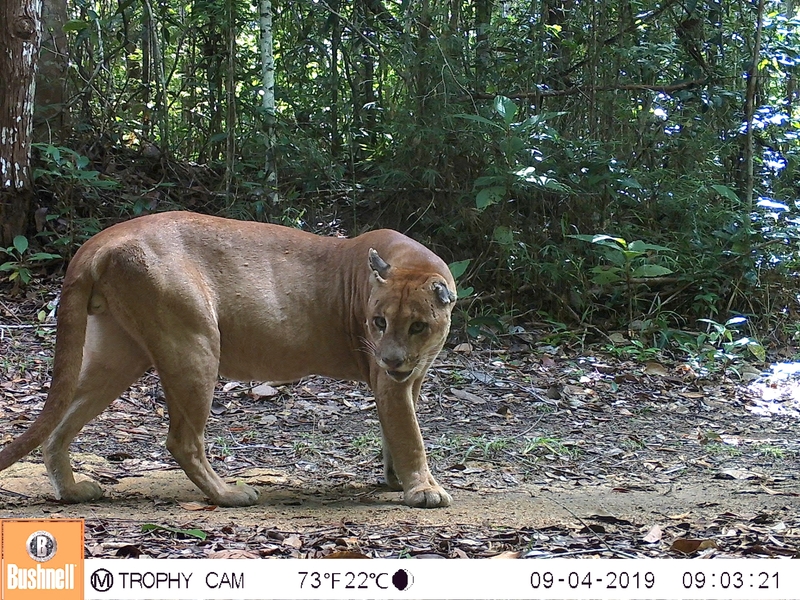The jaguar and mammal community in the extreme south of Bahia State
Population study and jaguar conservation in the northern portion of the Atlantic Rainforest: RPPN Estação Veracel – Pau-Brazil National Park
This project aims to monitor for the presence of jaguars (Panthera onca) and the assemblage of medium- and large-sized mammals in two protected areas at the Atlantic Forest of Southern Bahia, Brazil: RPPN Estação Veracel and Pau Brasil National Park. The jaguar is threatened in Bahia and Brazil, without any recent record in the study region for more than 20 years. Between 2016 and 2017, a jaguar individual was recorded in RPPN Estação Veracel, and with this record, the motivation to start this project arose. Our main objectives are to monitor for the presence of jaguars in both protected areas, and to survey the entire medium- and large-sized mammal assemblages, aiming to obtain information on the prey base for jaguars and to increase knowledge about mammal species that occur in the region. Southern Bahia is considered megadiverse, however, studies about mammals are still scarce in the region.
The project started in February 2018, when we delineated the sampling design and protocol for the camera trapping survey. From August 2018 to October 2019, we conducted three sampling campaigns lasting at least 60 days each, and deploying from 72 to 82 camera-traps per campaign in both study areas, totaling an effort of ~12000 trap-days. We recorded 30 species of medium- and large-sized mammals, 22 in RPPN Estação Veracel and 28 in Pau Brasil National Park. From these species, nine are threatened in Bahia, eight in Brazil, and four worldwide according to IUCN, including the margay (Leopardus wiedii), the southern tiger cat (Leopardus guttulus), the jaguarundi (Herpailurus yagouaroundi) and the puma (Puma concolor). Unfortunately, the jaguar was not recorded during the sampling period.
Due to the COVID-19 pandemic in Brazil, field work was temporarily suspended, aiming to return in the second half of 2021. Therefore, we focus on producing scientific articles from the data already collected, which resulted in two publications. The first was based on the striped hog-nosed skunk (Conepatus semistriatus), which was recorded at Pau Brasil National Park, an unexpected occurrence for the species in an area of dense forests. Then, we incorporated other primary records of the species from partners of Universidade de São Paulo, Universidade Estadual de Santa Cruz, and ICMBio/CENAP, and together with occurrence records compiled from the literature, we published in 2020 the article entitled ‘Flexible habitat use and range extension by the striped hog‑nosed skunk (Conepatus semistriatus) in Brazil’ in Mammalian Biology. This paper expands the occurrence area of the species in Brazil, besides of adding knowledge on its habitat use in the different biomes it occurs, Atlantic Forest, Cerrado and Caatinga (link: https://doi.org/10.1007/s42991-020-00056-4).
The second paper was developed as a result of the ‘Rede de Pesquisas de Conservação da Biodiversidade do Corredor Central da Mata Atlântica (REDE CONBIO)’, which is a collaborative research network of scientists and researchers working at the Atlantic Forest Central Corridor, between Espírito Santo and south of Bahia states. This research network was created as a result from reunions among member of this project, including Instituto Pró-Carnívoros, ICMBio/CENAP, Universidade Estadual de Santa Cruz, Pau Brasil National Park and RPPN Estação Veracel, to discuss the results from the camera trapping surveys. In this paper, we compiled primary data on medium- and large-sized mammals from 11 research projects and private environmental assessments conducted at the Atlantic Forest of Southern Bahia, from 42 researchers belonging to 23 different institutions, including universities, governmental research centers, nongovernmental organizations, and private companies. The article entitled ‘The role of protected and unprotected forest remnants for mammal conservation in a megadiverse Neotropical hotspot’ was published in 2021 in Biological Conservation, and presents information on the main patterns of richness, abundance and biomass of 72 mammal assemblages between protected an unprotected forest remnants in a region considered top priority for conservation in Brazil (link: https://doi.org/10.1016/j.biocon.2021.109173).
Operational area
atlantic-forest
Responsible team
Team
Marcelo Magioli (Instituto-Pró-Carnívoros e ICMBio/CENAP)
Ronaldo G. Morato (ICMBio/CENAP)
RPPN Estação Veracel
PARNA do Pau Brasil
Population study and jaguar conservation in the northern portion of the Atlantic Rainforest: RPPN Estação Veracel – Pau-Brazil National Park
This project aims to monitor for the presence of jaguars (Panthera onca) and the assemblage of medium- and large-sized mammals in two protected areas at the Atlantic Forest of Southern Bahia, Brazil: RPPN Estação Veracel and Pau Brasil National Park. The jaguar is threatened in Bahia and Brazil, without any recent record in the study region for more than 20 years. Between 2016 and 2017, a jaguar individual was recorded in RPPN Estação Veracel, and with this record, the motivation to start this project arose. Our main objectives are to monitor for the presence of jaguars in both protected areas, and to survey the entire medium- and large-sized mammal assemblages, aiming to obtain information on the prey base for jaguars and to increase knowledge about mammal species that occur in the region. Southern Bahia is considered megadiverse, however, studies about mammals are still scarce in the region.
The project started in February 2018, when we delineated the sampling design and protocol for the camera trapping survey. From August 2018 to October 2019, we conducted three sampling campaigns lasting at least 60 days each, and deploying from 72 to 82 camera-traps per campaign in both study areas, totaling an effort of ~12000 trap-days. We recorded 30 species of medium- and large-sized mammals, 22 in RPPN Estação Veracel and 28 in Pau Brasil National Park. From these species, nine are threatened in Bahia, eight in Brazil, and four worldwide according to IUCN, including the margay (Leopardus wiedii), the southern tiger cat (Leopardus guttulus), the jaguarundi (Herpailurus yagouaroundi) and the puma (Puma concolor). Unfortunately, the jaguar was not recorded during the sampling period.
Due to the COVID-19 pandemic in Brazil, field work was temporarily suspended, aiming to return in the second half of 2021. Therefore, we focus on producing scientific articles from the data already collected, which resulted in two publications. The first was based on the striped hog-nosed skunk (Conepatus semistriatus), which was recorded at Pau Brasil National Park, an unexpected occurrence for the species in an area of dense forests. Then, we incorporated other primary records of the species from partners of Universidade de São Paulo, Universidade Estadual de Santa Cruz, and ICMBio/CENAP, and together with occurrence records compiled from the literature, we published in 2020 the article entitled ‘Flexible habitat use and range extension by the striped hog‑nosed skunk (Conepatus semistriatus) in Brazil’ in Mammalian Biology. This paper expands the occurrence area of the species in Brazil, besides of adding knowledge on its habitat use in the different biomes it occurs, Atlantic Forest, Cerrado and Caatinga (link: https://doi.org/10.1007/s42991-020-00056-4).
The second paper was developed as a result of the ‘Rede de Pesquisas de Conservação da Biodiversidade do Corredor Central da Mata Atlântica (REDE CONBIO)’, which is a collaborative research network of scientists and researchers working at the Atlantic Forest Central Corridor, between Espírito Santo and south of Bahia states. This research network was created as a result from reunions among member of this project, including Instituto Pró-Carnívoros, ICMBio/CENAP, Universidade Estadual de Santa Cruz, Pau Brasil National Park and RPPN Estação Veracel, to discuss the results from the camera trapping surveys. In this paper, we compiled primary data on medium- and large-sized mammals from 11 research projects and private environmental assessments conducted at the Atlantic Forest of Southern Bahia, from 42 researchers belonging to 23 different institutions, including universities, governmental research centers, nongovernmental organizations, and private companies. The article entitled ‘The role of protected and unprotected forest remnants for mammal conservation in a megadiverse Neotropical hotspot’ was published in 2021 in Biological Conservation, and presents information on the main patterns of richness, abundance and biomass of 72 mammal assemblages between protected an unprotected forest remnants in a region considered top priority for conservation in Brazil (link: https://doi.org/10.1016/j.biocon.2021.109173).
Região de atuação
atlantic-forest
Equipe responsável
Team
Marcelo Magioli (Instituto-Pró-Carnívoros e ICMBio/CENAP)
Ronaldo G. Morato (ICMBio/CENAP)
RPPN Estação Veracel
PARNA do Pau Brasil
